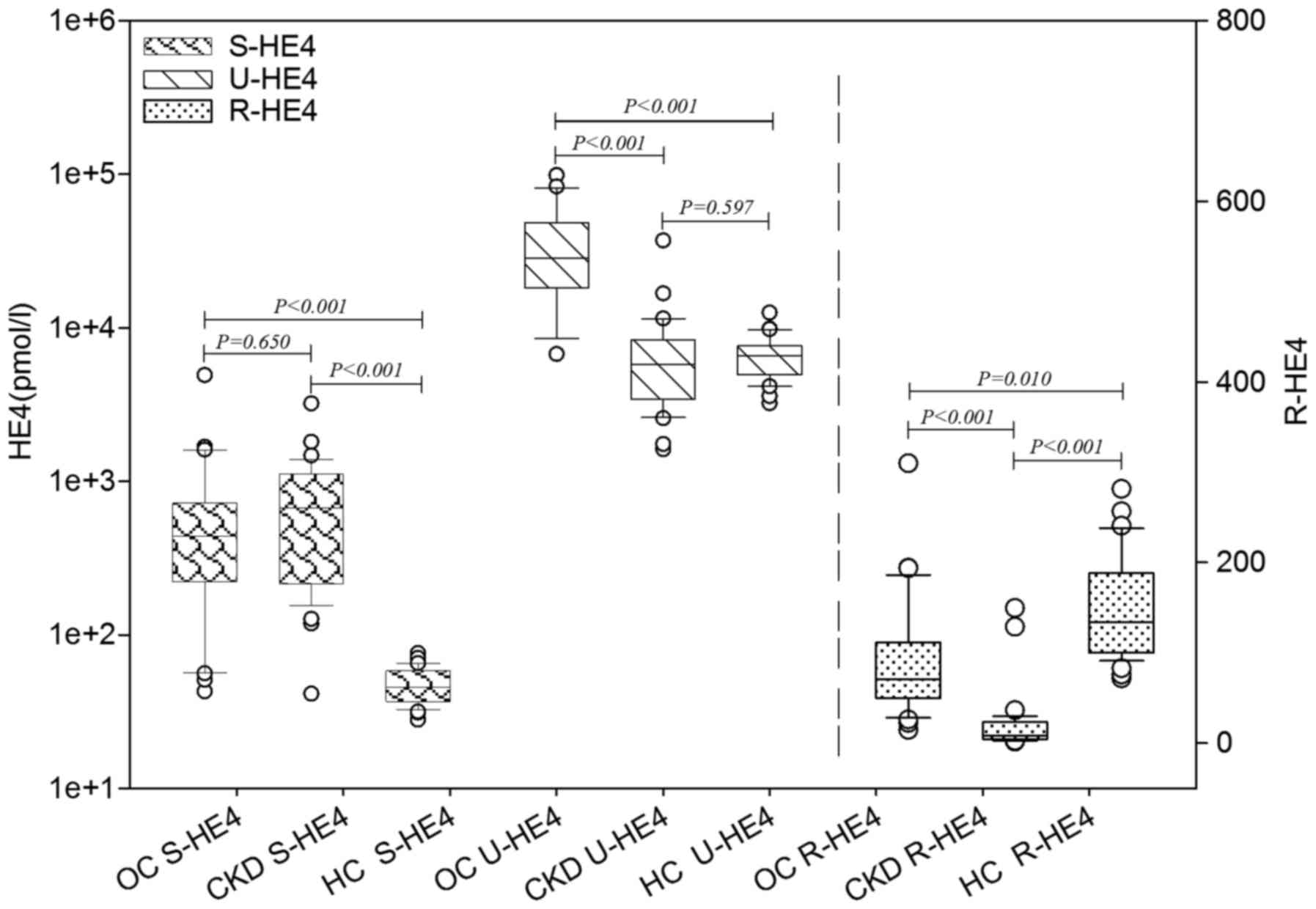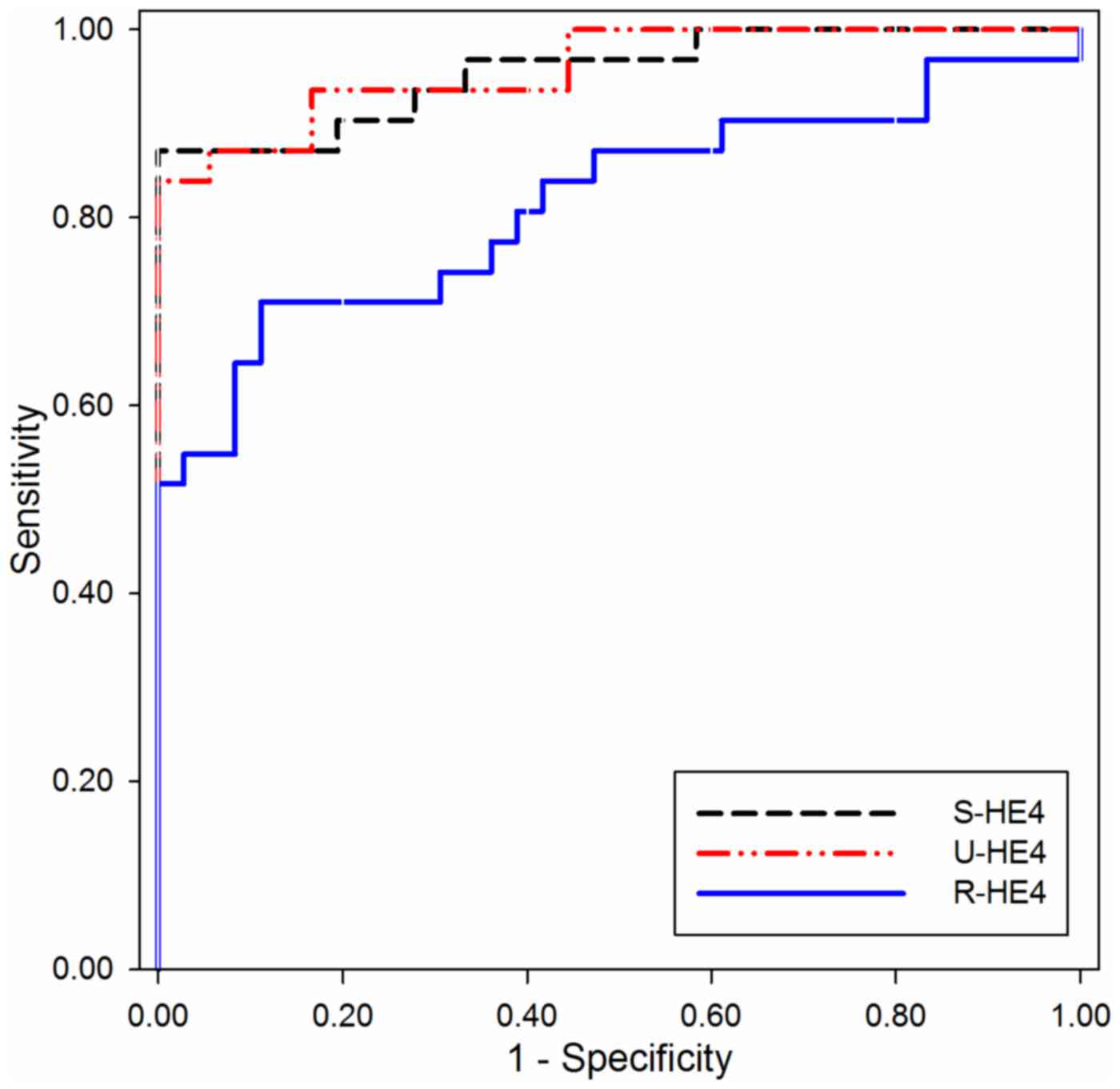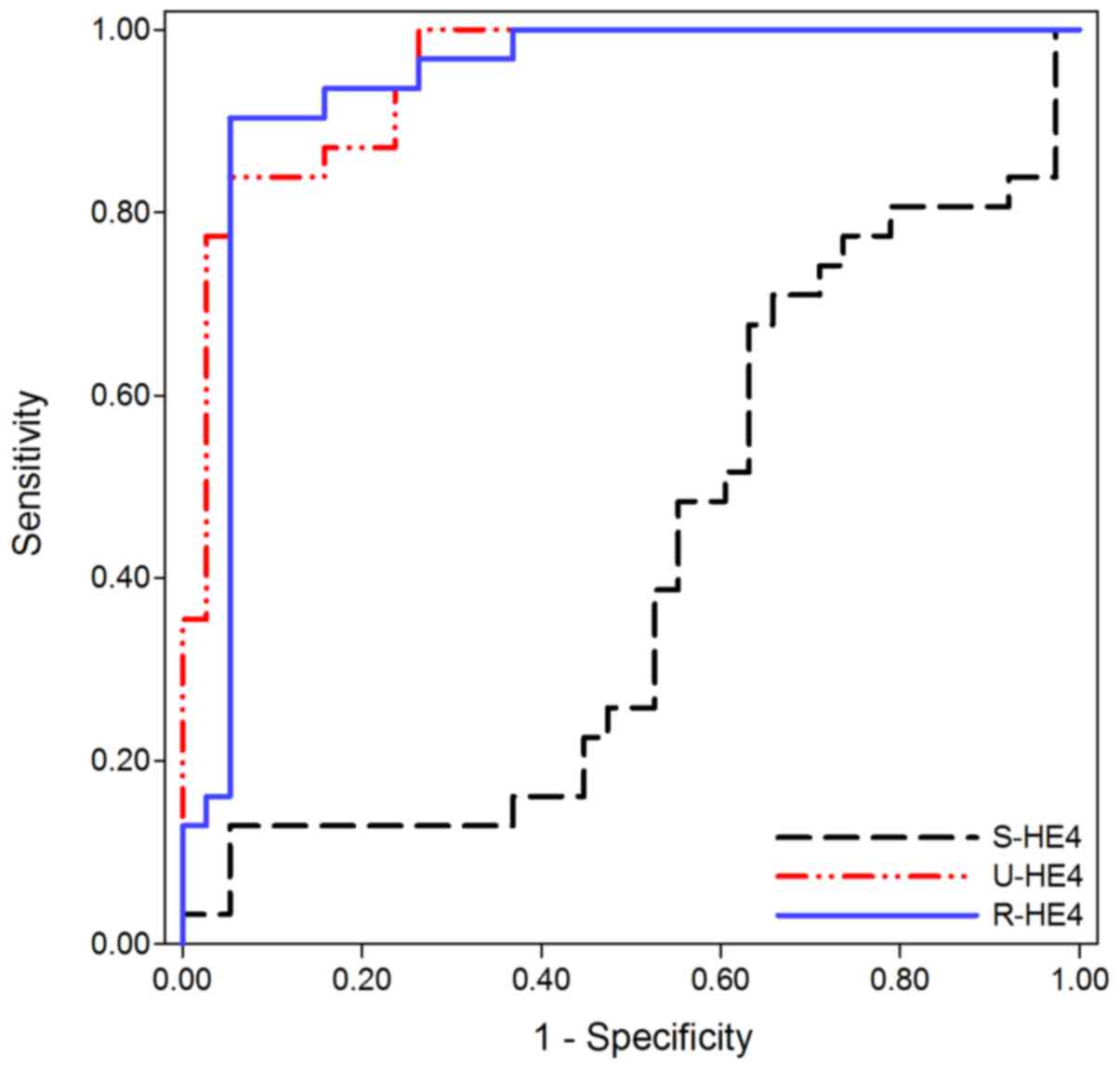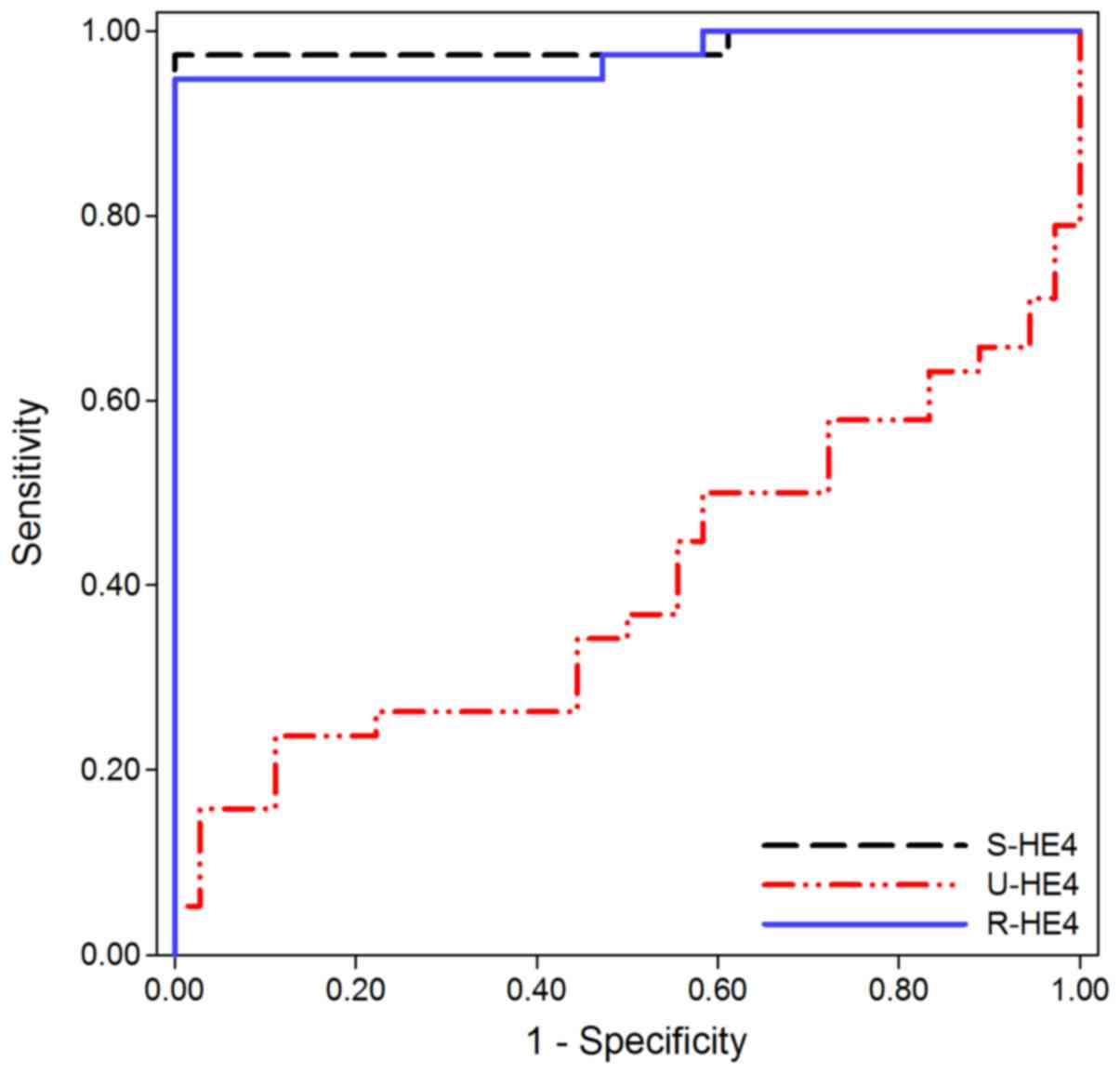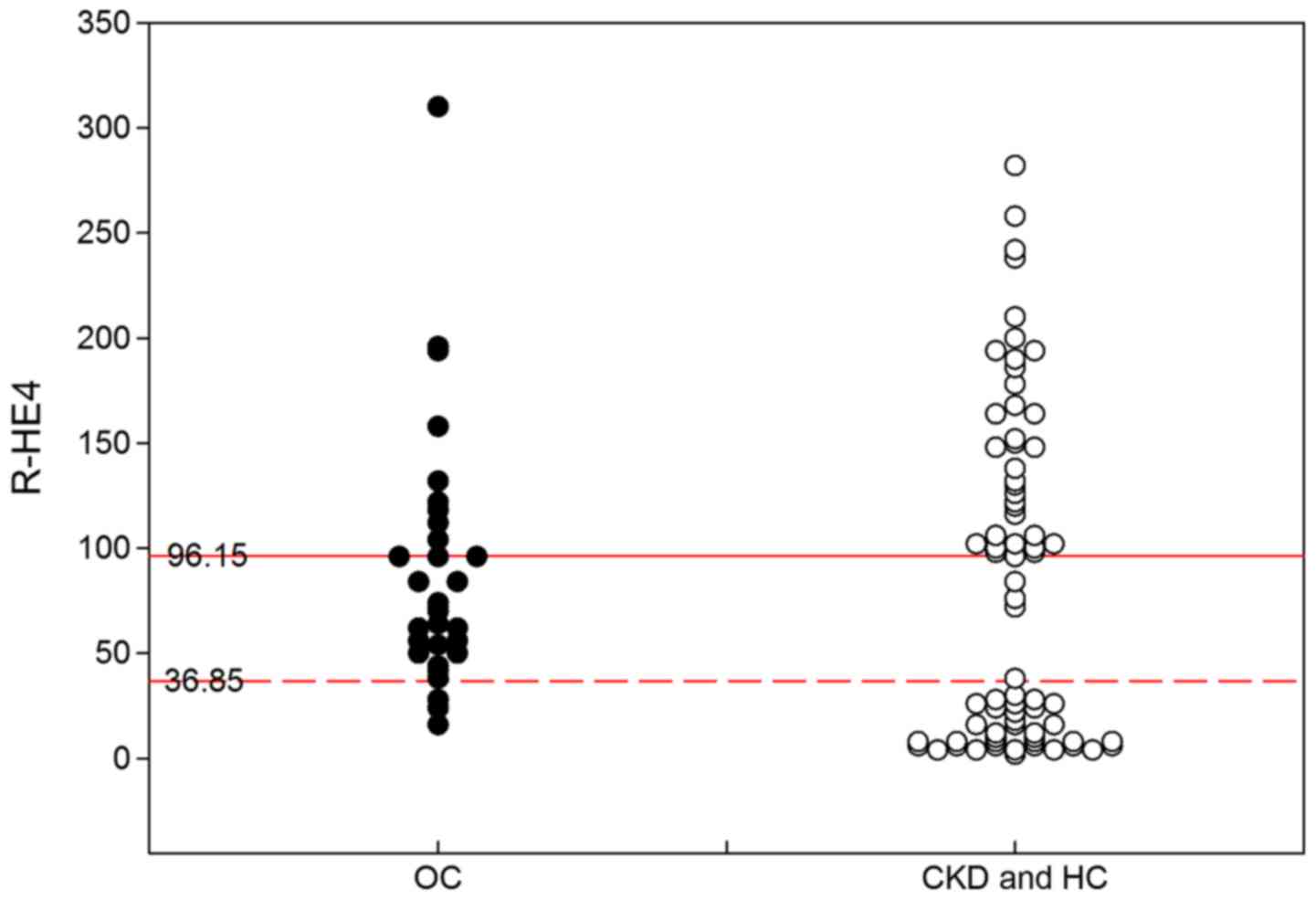|
1
|
Jayson GC, Kohn EC, Kitchener HC and
Ledermann JA: Ovarian cancer. Lancet. 384:1376–1388. 2014.
View Article : Google Scholar : PubMed/NCBI
|
|
2
|
Bristow RE, Chang J, Ziogas A, Randall LM
and Anton-Culver H: High-volume ovarian cancer care: Survival
impact and disparities in access for advanced-stage disease.
Gynecol Oncol. 132:403–410. 2014. View Article : Google Scholar : PubMed/NCBI
|
|
3
|
Hamed EO, Ahmed H, Sedeek OB, Mohammed AM,
Abd-Alla AA and Ghaffar HM Abdel: Significance of HE4 estimation in
comparison with CA125 in diagnosis of ovarian cancer and assessment
of treatment response. Diagn Pathol. 8:112013. View Article : Google Scholar : PubMed/NCBI
|
|
4
|
Kappelmayer J, Antal-Szalmás P and Nagy B
Jr: Human epididymis protein 4 (HE4) in laboratory medicine and an
algorithm in renal disorders. Clin Chim Acta. 438:35–42. 2015.
View Article : Google Scholar : PubMed/NCBI
|
|
5
|
Speeckaert MM, Speeckaert R and Delanghe
JR: Human epididymis protein 4 in cancer diagnostics: A promising
and reliable tumor marker. Adv Clin Chem. 59:1–21. 2013. View Article : Google Scholar : PubMed/NCBI
|
|
6
|
Terlikowska KM, Dobrzycka B, Witkowska AM,
Mackowiak-Matejczyk B, Sledziewski TK, Kinalski M and Terlikowski
SJ: Preoperative HE4, CA125 and ROMA in the differential diagnosis
of benign and malignant adnexal masses. J Ovarian Res. 9:432016.
View Article : Google Scholar : PubMed/NCBI
|
|
7
|
Wei SU, Li H and Zhang B: The diagnostic
value of serum HE4 and CA-125 and ROMA index in ovarian cancer.
Biomed Rep. 5:41–44. 2016.PubMed/NCBI
|
|
8
|
Xu Y, Zhong R, He J, Ding R, Lin H, Deng
Y, Zhou L, Li X, Jiang J, Bao Y, et al: Modification of cut-off
values for HE4, CA125 and the ROMA algorithm for early-stage
epithelial ovarian cancer detection: Results from 1021 cases in
South China. Clin Biochem. 49:32–40. 2016. View Article : Google Scholar : PubMed/NCBI
|
|
9
|
Zhang P, Wang C, Cheng L, Zhang P, Guo L,
Liu W, Zhang Z, Huang Y, Ou Q, Wen X, et al: Development of a
multi-marker model combining HE4, CA125, progesterone, and
estradiol for distinguishing benign from malignant pelvic masses in
postmenopausal women. Tumour Biol. 37:2183–2191. 2016. View Article : Google Scholar : PubMed/NCBI
|
|
10
|
Liao JB, Yip YY, Swisher EM, Agnew K,
Hellstrom KE and Hellstrom I: Detection of the HE4 protein in urine
as a biomarker for ovarian neoplasms: Clinical correlates. Gynecol
Oncol. 137:430–435. 2015. View Article : Google Scholar : PubMed/NCBI
|
|
11
|
Wan J, Wang Y, Cai G, Liang J, Yue C, Wang
F, Song J, Wang J, Liu M, Luo J, et al: Elevated serum
concentrations of HE4 as a novel biomarker of disease severity and
renal fibrosis in kidney disease. Oncotarget. 7:67748–67759.
2016.PubMed/NCBI
|
|
12
|
Mckinnon B, Mueller MD, Nirgianakis K and
Bersinger NA: Comparison of ovarian cancer markers in endometriosis
favours HE4 over CA125. Mol Med Rep. 12:5179–5184. 2015.PubMed/NCBI
|
|
13
|
Anton C, Carvalho FM, Oliveira EI, Maciel
GA, Baracat EC and Carvalho JP: A comparison of CA125, HE4, risk
ovarian malignancy algorithm (ROMA), and risk malignancy index
(RMI) for the classification of ovarian masses. Clinics (Sao
Paulo). 67:437–441. 2012. View Article : Google Scholar : PubMed/NCBI
|
|
14
|
Nagy B Jr, Krasznai ZT, Balla H, Csobán M,
Antal-Szalmás P, Hernádi Z and Kappelmayer J: Elevated human
epididymis protein 4 concentrations in chronic kidney disease. Ann
Clin Biochem. 49:377–380. 2012. View Article : Google Scholar : PubMed/NCBI
|
|
15
|
Piek A, Meijers WC, Schroten NF,
Gansevoort RT, de Boer RA and Sillje HH: HE4 Serum levels are
associated with heart failure severity in patients with chronic
heart failure. J Card Fail. 23:12–19. 2017. View Article : Google Scholar : PubMed/NCBI
|
|
16
|
Yang Z, Zhang Z, Qin B, Wu P, Zhong R,
Zhou L and Liang Y: Human Epididymis Protein 4: A novel biomarker
for Lupus nephritis and chronic kidney disease in systemic Lupus
erythematosus. J Clin Lab Anal. 30:897–904. 2016. View Article : Google Scholar : PubMed/NCBI
|
|
17
|
Lv YW, Yang L, Zhang M, Jiang LH, Niu JH,
Hou J and Cui XH: Increased human epididymis protein 4 in benign
gynecological diseases complicated with chronic renal insufficiency
patients. Genet Mol Res. 14:2156–2161. 2015. View Article : Google Scholar : PubMed/NCBI
|
|
18
|
Macuks R, Baidekalna I and Donina S:
Urinary concentrations of human epidydimis secretory protein 4
(He4) in the diagnosis of ovarian cancer: A case - control study.
Asian Pac J Cancer Prev. 13:4695–4698. 2012. View Article : Google Scholar : PubMed/NCBI
|
|
19
|
Hellstrom I, Heagerty PJ, Swisher EM, Liu
P, Jaffar J, Agnew K and Hellstrom KE: Detection of the HE4 protein
in urine as a biomarker for ovarian neoplasms. Cancer Lett.
296:43–48. 2010. View Article : Google Scholar : PubMed/NCBI
|
|
20
|
FIGO Committee on Gynecologic Oncology, .
FIGO staging for carcinoma of the vulva, cervix, and corpus uteri.
Int J Gynaecol Obstet. 125:97–98. 2014. View Article : Google Scholar : PubMed/NCBI
|
|
21
|
Kidney Disease Improving Global Outcomes
(KDIGO) CKD Work Group, . KDIGO 2012 clinical practice guideline
for the evaluation and management of chronic kidney disease. Kidney
inter. 3:1–150. 2013.
|
|
22
|
Levey AS, Stevens LA, Schmid CH, Zhang YL,
Castro AF III, Feldman HI, Kusek JW, Eggers P, van Lente F, Greene
T and Coresh J; CKD-EPI (Chronic Kidney Disease Epidemiology
Collaboration), : A new equation to estimate glomerular filtration
rate. Ann Intern Med. 150:604–612. 2009. View Article : Google Scholar : PubMed/NCBI
|
|
23
|
Ferraro S, Braga F, Lanzoni M, Boracchi P,
Biganzoli EM and Panteghini M: Serum human epididymis protein 4 vs
carbohydrate antigen 125 for ovarian cancer diagnosis: A systematic
review. J Clin Pathol. 66:273–281. 2013. View Article : Google Scholar : PubMed/NCBI
|
|
24
|
Gündüz UR, Gunaldi M, Isiksacan N, Gündüz
S, Okuturlar Y and Kocoglu H: A new marker for breast cancer
diagnosis, human epididymis protein 4: A preliminary study. Mol
Clin Oncol. 5:355–360. 2016.PubMed/NCBI
|
|
25
|
Lamy PJ, Plassot C and Pujol JL: Serum
HE4: An independent prognostic factor in non-small cell lung
cancer. PLoS One. 10:e01288362015. View Article : Google Scholar : PubMed/NCBI
|



